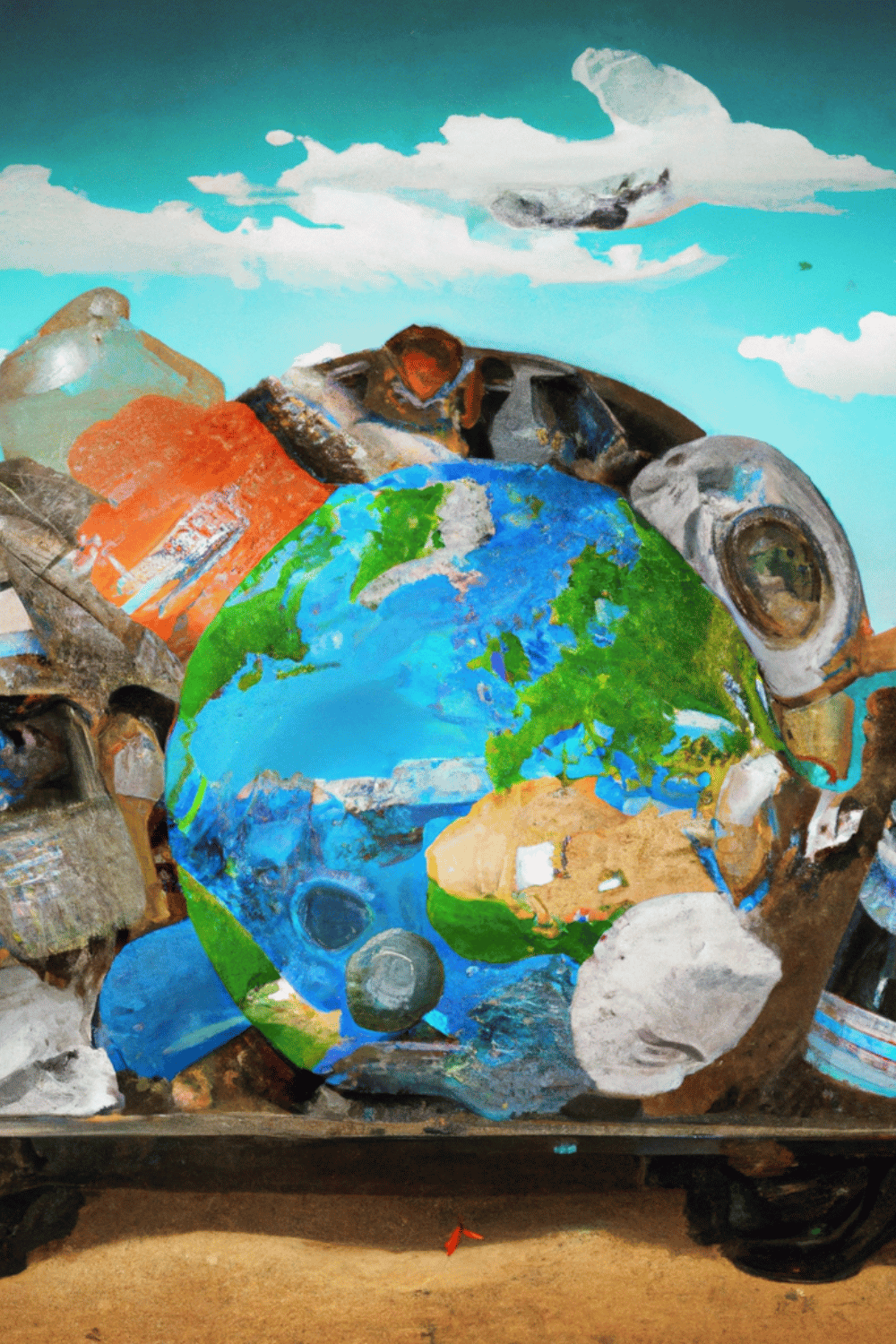History of Recycling: Introduction
The ancient adage, “One man’s trash is another man’s treasure,” encapsulates the essence of recycling, a practice that has deep historical roots. Contrary to the misconception that recycling is a recent phenomenon, the concept of turning waste into valuable resources has persisted for thousands of years. To truly appreciate the significance of modern recycling efforts, we must embark on a journey through time to explore the rich history of recycling.
The Concept of Recycling
Recycling isn’t merely about the simple act of tossing a soda can into the appropriate bin. It encompasses a comprehensive, cyclical process that has evolved over centuries. This intricate dance of sustainability involves the collection of resources, their processing, transformation into new materials or products, utilization, and eventually, their return to the recycling loop. It’s a harmonious choreography where nothing goes to waste, and resources are continuously renewed and repurposed.
Why is Recycling Important?
The importance of recycling extends far beyond the act of keeping our streets clean. At its core, recycling is an environmental superhero, swooping in to combat a multitude of ecological challenges. Without recycling, our communities would be drowning in mountains of unmanageable garbage. Landfills would overflow, emitting harmful gases and leaching toxins into the soil.
However, recycling is not just about waste management. It’s a powerful force for good on multiple fronts. When we recycle, we save precious energy that would otherwise be expended in extracting and processing raw materials. We also preserve natural resources, from trees to metals, by reducing the demand for virgin materials. This resource conservation not only safeguards our environment but also bolsters our economy. Additionally, recycling plays a pivotal role in reducing pollution, curbing greenhouse gas emissions, and mitigating the harmful effects of climate change.
In summary, the history of recycling is a testament to the enduring human drive to protect our planet and utilize resources wisely. While the methods and technologies have evolved over time, the fundamental principles of recycling—reusing, repurposing, and renewing—have remained constant. Recycling is not just an act; it’s a philosophy, a commitment to sustainability that empowers us to be stewards of our environment and champions of a greener, cleaner future.
History of Recycling: Early Instances of Recycling
Recycling is a practice deeply rooted in human history. It can be traced back to the Bronze Age when our ancestors displayed an early penchant for reusing materials. During this period, people would collect and melt down old metals, such as copper and bronze, to forge new tools and artifacts. This pragmatic approach exemplified the age-old adage, “waste not, want not,” as they recognized the value of repurposing resources for their benefit. This early form of recycling laid the foundation for more sophisticated recycling practices in subsequent civilizations.
Ancient Civilizations and Recycling
As civilizations advanced, so did their recycling techniques. Ancient societies across the world exhibited a remarkable commitment to reusing materials, contributing to the sustainability of their communities and ecosystems.
Recycling in the Roman Empire
The Roman Empire stands out in the history of recycling for its innovative approach. Romans were not only adept at conquest but also at recycling. After military campaigns, they collected discarded iron weapons from battlefields, returning them to smelting facilities. These weapons were melted down to extract valuable iron, which was then used to forge new weapons and tools. This recycling strategy served a dual purpose, enhancing both environmental conservation and the empire’s military strength.
Recycling in Ancient Japan
Japan, in the 17th century, showcased its own unique recycling practices. During this period, old manuscripts and documents were subjected to a remarkable transformation. Rather than discarding them, these materials were soaked, beaten, and meticulously transformed into fresh sheets of paper. This process marked a significant step in the history of recycling by demonstrating the potential to extend the life of written records and reduce the demand for new paper production.
Recycling in Medieval Europe
Medieval Europe was no stranger to recycling either. Blacksmiths of this era played a pivotal role in resource conservation. They often repurposed old and worn metal objects, including tools and weaponry, by melting them down and skillfully forging them into new items. This practice not only prolonged the life of valuable resources but also ensured that precious metals did not go to waste. Recycling, during medieval times, was deeply ingrained in the fabric of society, contributing to the sustainability and resilience of communities.
In summary, the history of recycling is a testament to humanity’s enduring commitment to resource conservation and environmental responsibility. From the Bronze Age to the Roman Empire, ancient Japan to medieval Europe, various civilizations have demonstrated their ingenuity in repurposing materials to meet their needs. These early instances of recycling not only preserved resources but also laid the groundwork for modern recycling practices that continue to be essential in our efforts to build a more sustainable future.
The Birth of Modern Recycling
Scrap Dealers and Rag-Pickers
The industrial revolution brought about a major shift in recycling. Rag-and-bone men wandered the streets, collecting everything from bones to metals, and selling them back to industries. They were the unsung heroes of recycling!
The Effect of Urbanization on Recycling
As cities grew, so did waste. But with waste came opportunity. The increasing demand for raw materials meant that scrap became a valuable commodity.
Recycling during and after World Wars
As the world plunged into the tumultuous period of the World Wars, recycling took on an air of patriotism. It became a survival strategy, a matter of national security even.
World War Efforts
During the wars, materials were scarce, and waste was not an option. Metals, rubber, paper, even kitchen fats were collected and reused to aid the war effort. People were encouraged to conserve resources, and recycling became a civic duty. Posters of the era proudly declared, “We can do it!” and every scrap mattered.
Post-War Recycling Trends
But as the wars ended, and the world entered a period of relative peace and prosperity, recycling took a bit of a backseat. The advent of single-use materials and the consumerist culture of the time saw recycling rates drop. People were drawn to the convenience of disposable products, and waste started to pile up. However, the planet couldn’t keep up, and it was becoming clear that something had to change.
The Environmental Movement and Recycling
Enter the 1970s, a pivotal decade for recycling. The era was marked by heightened awareness about the environment and a growing recognition of the unsustainable nature of our consumption patterns.
Rise of Environmental Consciousness
This decade witnessed the birth of the modern environmental movement. Triggered by concerns over pollution, deforestation, and waste, people started to question the status quo. They began to see that the convenience of disposable products came with a hefty price tag for our planet.
Emergence of Curbside Recycling
During this period, curbside recycling programs started popping up, making recycling more accessible to the everyday person. No longer did people have to go out of their way to recycle. The recycling bin was now just a step away from the trash can, which was a game-changer.
Introduction of Recycling Symbols
It was also in the 1970s that the recycling symbol, known as the Mobius Loop, came into existence. This symbol, a trio of chasing arrows forming an unbroken loop, became an international symbol for recycling. It was a constant reminder of the cyclical nature of resources and our responsibility to keep that cycle going.
Impact of the Environmental Movement
The environmental movement helped shift public perception and policy towards recycling. Recycling was no longer seen just as an economic activity or wartime necessity but recognized as a crucial component in preserving our planet. It highlighted the need for sustainable practices and put recycling in the spotlight, where it has remained ever since.
Recycling Technologies
Recycling has come a long way from manual sorting and simple metal reprocessing. As we navigate the increasing complexity of waste materials, various innovative technologies have emerged, making recycling more efficient and effective.
Automated Sorting Systems
These systems have revolutionized the recycling process. They use optical sensors, magnets, and air jets to sort recyclables by material type automatically. For example, infrared sensors can identify different types of plastics based on their unique signatures, while magnets can separate ferrous metals from the mixed waste stream.
These automated sorting systems significantly increase the speed and efficiency of recycling processes while reducing the need for manual labor and the risk of contamination.
Bioremediation
Bioremediation is a fascinating development in recycling technology that uses living organisms—like bacteria, fungi, and plants—to neutralize or eliminate environmental contaminants. For instance, certain bacteria can metabolize hazardous substances, such as oil spills, rendering them harmless.
Bioremediation in the realm of recycling holds great promise for breaking down difficult-to-recycle materials, like some types of plastic. Recent research has even discovered bacteria that can eat certain plastics, converting them into benign byproducts.
Electronic Waste Recycling
As technology advances, electronic waste—or e-waste—has grown exponentially. This includes everything from old cell phones and computers to TVs and refrigerators.
E-waste recycling is a complex process, as these devices often contain a mix of materials, including some that can be hazardous if not handled properly. Fortunately, new technologies are being developed to safely and efficiently recover valuable materials from e-waste.
For instance, hydrometallurgical processes use chemical solutions to recover precious metals like gold, silver, and palladium from electronic devices. Meanwhile, mechanical processes can safely dismantle e-waste, separating out different components for recycling.
Advanced Thermal Treatment
Advanced thermal treatment technologies, such as pyrolysis and gasification, offer another promising solution for recycling. These processes use heat to break down waste materials into their basic components without combustion.
Pyrolysis, for example, can convert plastics back into oil, while gasification can turn organic waste into synthetic gas (syngas), a valuable energy source. These technologies enable us to recycle a wider range of materials and provide a way to recover energy from waste.
With these and more innovations on the horizon, the recycling industry is becoming more dynamic and capable of handling the evolving waste stream. As these technologies continue to develop, they pave the way for a more sustainable and resource-efficient future.
Recycling Challenges and Solutions
Despite the significant progress and technological advancements, the recycling industry still grapples with several challenges. These range from logistical to technical to societal issues.
Common Recycling Issues
One of the major roadblocks to efficient recycling is contamination. It happens when non-recyclable or dirty recyclables are mixed with clean, recyclable materials. For instance, a greasy pizza box in a paper recycling bin can spoil an entire batch of paper, rendering it non-recyclable.
Inefficient recycling processes also pose a problem. Many municipalities still rely on outdated systems, leading to lower recovery rates and contamination levels.
Additionally, a lack of awareness and understanding about recycling continues to be a concern. Misconceptions about what can be recycled, how to recycle correctly, and the impact of not recycling often contribute to low recycling rates.
How We Can Improve Recycling
To address these challenges, a comprehensive, multipronged strategy is necessary.
For starters, we need to invest in education. Public campaigns, school programs, and other initiatives can help raise awareness about the importance of recycling and teach people how to recycle properly.
Improving recycling technologies is another crucial aspect. We must continue innovating and adopting technologies that can enhance sorting, processing, and recycling efficiency.
Policy interventions can also make a significant impact. For instance, Extended Producer Responsibility (EPR) regulations make manufacturers responsible for the end-of-life management of their products, incentivizing them to design more recyclable products and contribute to recycling programs.
Remember, change starts at the grassroots level. Each of us making a conscious effort to recycle can collectively lead to significant improvements.
The Future of Recycling
The future of recycling looks promising, filled with innovative technologies and progressive strategies.
Artificial Intelligence (AI) and robotics are emerging as game-changers in the recycling industry. AI-powered systems can identify and sort recyclables with remarkable accuracy, leading to reduced contamination and increased efficiency.
Meanwhile, robotics in recycling facilities can perform tasks that were once labor-intensive and hazardous for humans. Robots can sort through mixed waste, extract valuable materials, and even dismantle electronic waste.
Bio-recycling is another promising frontier. It involves using biological organisms, like bacteria or fungi, to break down waste. For instance, certain types of bacteria can “eat” plastic, converting it into valuable chemicals.
On a societal level, we’re likely to see a growing emphasis on a circular economy – an economic system aimed at eliminating waste and continually using resources. In a circular economy, products are designed to be reused and recycled, and waste is seen as a resource rather than a problem.
Moreover, we can expect more initiatives encouraging consumers to play an active role in recycling. This could mean more accessible recycling programs, better product labeling, and incentives for responsible waste disposal.
The future is undoubtedly exciting, filled with innovations and advancements that will take recycling to new heights. As we adapt and evolve, the goal remains to preserve our planet for future generations.
Conclusion
As we journey through the riveting history of recycling, it’s clear that this humble act of repurposing holds a power far greater than we often acknowledge. From its humble beginnings in the times of our resourceful ancestors, through the thriftiness demanded by world wars, to the environmental consciousness of the 1970s, and finally, to the sophisticated, technology-driven industry of today – recycling has been a silent hero, helping us make the most of our resources while reducing the strain on our precious planet.
But here’s the thing, dear Earth lovers: The journey of recycling isn’t just history – it’s also our future. As we grapple with the mounting challenges of waste management and climate change, recycling becomes not just a helpful act but an essential strategy for survival. It’s a key piece in the jigsaw puzzle of sustainable living, enabling us to continue enjoying life’s conveniences without compromising the health of our planet.
So, as we stand at the crossroads of a world struggling to balance progress with sustainability, let’s remember the lessons that history has taught us. Let’s strive for a future where recycling is not an afterthought but an integral part of our lifestyle and production systems. Because ultimately, it’s not just about saving resources or reducing waste – it’s about preserving our home, the Earth, for future generations.
As we move forward, let’s carry the torch of recycling proudly, ensuring that this practice, which has stood the test of time, continues to evolve and thrive. Let’s stay curious, embrace innovation, and never stop asking how we can improve recycling because, as the history of recycling shows us, every effort counts, and every individual can make a difference.
The history of recycling is a testament to human ingenuity and resilience. It’s a story of adaptation, of making do, of finding value in the unexpected. And as we write the next chapters of this story, I have no doubt that we’ll continue to surprise ourselves with our creativity, resourcefulness, and relentless commitment to making the world a better place. So, my dear friend, let’s keep the cycle going! Happy recycling!
FAQs
How did recycling start?
Recycling started thousands of years ago as a practical way to reuse valuable materials. As civilizations grew and technologies advanced, recycling processes became more complex and widespread.
Why was recycling important during the World Wars?
The history of recycling shows that during the World Wars, resources were scarce. Recycling became crucial to supply materials for war efforts. Every scrap of metal, rubber, and even kitchen fats were collected and reused to support the war effort.
When did modern recycling start?
The birth of modern recycling can be traced back to the environmental movement of the 1970s. This movement led to establishing the first curbside recycling programs and adopting the Mobius Loop as the international symbol for recycling.
How has recycling technology changed over time?
The history of recycling takes us from rag-and-bone men to high-tech machines; recycling technology has come a long way. Today’s recycling facilities use sophisticated machinery and technologies, including AI and robotics, to sort and process recyclables.
What’s the future of recycling?
The future of recycling is bound to be even more technologically advanced. With continuous research and development, we can expect new technologies and strategies to make recycling more efficient, sustainable, and widespread.





Pingback: Benefits of Recycling: Maximizing Your Impact for a Greener Planet
Pingback: Facts About Recycling: Conserving Resources & Building Sustainability
Pingback: Why Recycle? Your Ultimate Guide to the Big Green Reason
Pingback: Why is Recycling Important? A Definitive Guide - Eco Life Wise
Pingback: Recycled Art: An Eco Friendly Approach to Creativity
Pingback: Bokashi Composting: Green Thumbs, Unite!
Pingback: How to Make Compost: A Guide to a Greener Garden
Pingback: Goodwill Recycling: Transforming Lives and Our Planet
Pingback: 15 Facts About Recycling You Probably Didn't Know
Pingback: What is Coral Bleaching? A Fascinating Dive Underwater | Eco Life Wise
Pingback: Recycling for Kids: A Journey Towards a Sustainable Future
Pingback: Eco Friendly Gifts: A Sustainable Guide | Eco Life Wise
Pingback: Sustainable Fashion Brands: Redesigning Style Responsibly
Pingback: Is Cardboard Recyclable? You Might Be Surprised | Eco Life Wise
Pingback: Climate Change Facts for Kids: A Cool Guide for a Hot Topic | Eco Life Wise
Pingback: Self Sustainable Homes: 7 Practical Reasons Why You Need One Today! | Eco Life Wise
Pingback: Recycling for Kids: Discover the Secrets of Saving the Planet
Pingback: Examples of Natural Resources: Unearthing Earth's Treasures | Eco Life Wise
Pingback: What can we learn about recycling from ancient civilizations? – A Better Man